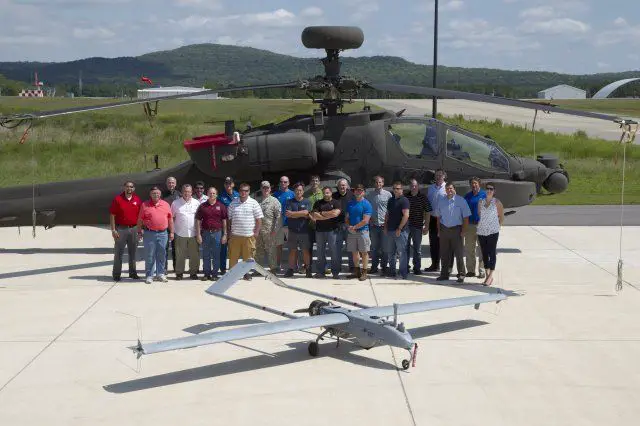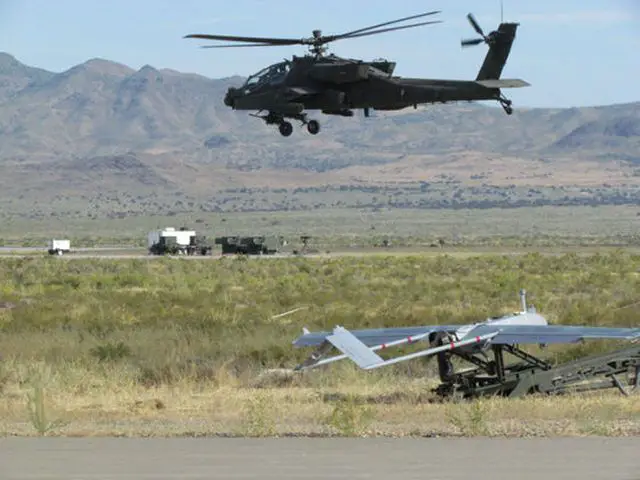Breaking news
US Army shows new capabilities for UAS and AH-64E Apache teaming.
| a | |||||
Defence & Security News - United States |
|||||
| Thursday, October 9, 2014 11:31 AM | |||||
| US Army shows new capabilities for UAS and AH-64E Apache teaming | |||||
The
Gray Eagle and Shadow unmanned aircraft systems, or UAS have proven themselves
up to the challenge in a series of manned-unmanned teaming tests with
the U.S. Army's newest Apache, the AH-64 "E" model, and the
One System Remote Video Terminal during the past two months at both Redstone
Arsenal and El Mirage Flight Test Facility in California. |
|||||
 Recent tests proved that capabilities have been successfully increased so that Apache helicopter pilots can control the payloads, sensors and flight of UAS from the cockpit of their helicopter |
|||||
The
successful tests took the two unmanned aircraft systems into the realm
of true interoperability between multiple Army aviation systems. While
unmanned aircraft systems have been transmitting surveillance video to
helicopter pilots via a ground station control system since 2007, the
recent tests proved that capabilities have been successfully increased
so that Apache helicopter pilots can control the payloads, sensors and
flight of unmanned aircraft systems from the cockpit of their helicopter.
In addition, the tests proved the capabilities of the latest version of
the One System Remote Video Terminal to control the sensors of UAS.
"During our test events, we've taken the manned-unmanned capabilities of Shadow and Gray Eagle, and the Apache "E" model to a level where the Apache cannot only receive information but also transmit command and control to the unmanned systems," said Doug Wolfe, interoperability lead, Common Systems Integration, Unmanned Aircraft Systems Project Office, Program Executive Office for Aviation. "We've also tested the use of a One System Remote Video Terminal, where the Soldiers in the fight can use the OSRVT to control the sensors on all unmanned aircraft systems. Right now, the OSRVT allows the receipt of data from different UAS," Wolfe continued. "But the next version will make OSRVT bi-directional so that it cannot only receive from all UAS, but also transmit to all UAS to control their payloads." The Gray Eagle UAS, the largest unmanned aircraft system in the Army's arsenal of weapons, has a mission that includes wide-ranged intelligence, surveillance and reconnaissance; convoy protection; IED detection and defeater; close air support; target acquisition; communications relay and weapons delivery. It can operate up to 25 hours, flies up to 29,000 feet and can carry multiple payloads, including four Hellfire missiles. The Shadow UAS is used by brigade commanders for reconnaissance, surveillance, targeting and assessment. It can conduct missions up to 125 kilometers away from the ground control stations, and recognize tactical vehicles up to 8,000 feet above the ground at a range of more than 3.5 kilometers, day or night. The Gray Eagle and Shadow are the anchor systems in an Army UAS fleet that also includes the much smaller Puma and Raven UAS, and the Army's first UAS, Hunter. Since 2007, Army aviation has flown more than 5.85 million flight hours in manned-unmanned teaming scenarios, both in training and on the battlefield. Manned-unmanned teaming is possible due to the standardization of video and data transmission systems between ground station control, unmanned aircraft systems and manned platforms. The manned-unmanned network allows manned helicopters to control unmanned aircraft payloads, and the receiving and transmitting of real-time video. "These new capabilities are a force multiplier for infantry and field artillery," Wolfe said. "The experiences we've had with this testing have exceeded my expectations. I am very positive about the results of our testing and the capabilities that will be provided to the war fighter." For about two and a half years, PEO Aviation engineers have been working with its partners in both government and industry to increase manned-unmanned teaming capabilities, said Ricardo Jaramillo, interoperability profile lead for Gray Eagle. "We've had several anomalies along the way that we've had to work through," he said. "And we did work through them so my expectation was that everything would work just as advertised, and it did." |
|||||
 "Shadow is the scout. Apache is the killer. And together they are a synergistic team of aviation assets that engage targets" |
|||||
Apache
helicopter pilots are familiar with flying with UAS in the battle space,
said Sean Gilpin, UAS Level IV interoperability lead, Apache Project Office,
PEO Aviation.
"Our Apache pilots are the human machine interface in manned-unmanned teaming. We have fielded manned-unmanned capabilities with our 'E' model Apache," he said. "Unmanned aircraft help to take away the unknown on the battlefield because they can fly out from the Apache and allow the Apache pilot to see over the horizon. Any additional capabilities we can provide above what we have now will only make it better for our Apache pilots. The response from the field is that Soldiers really like it." Manned-unmanned teaming already brings several assets to the battlefield, including improved air-ground integration, increased operational tempos, rapid development of situations when engaged, increased endurance allowing manned platforms to action real-time intelligence, increased lethality, increased survivability by reducing the unknown about enemy force disposition, persistent surveillance allowing manned aircraft to focus on high payoff targets and reliable combat information in real time. The team of defense contractors supporting the testing included Textron, General Atomics, Boeing, Lockheed Martin and Northrop Grumman. In
addition, the Aviation and Missile Research Development and Engineering
Center, known as AMRDEC, provided the support needed to test in the Joint
Systems Integration Lab at Redstone. "When we put both UAS and Apache in flight, with the ground control station then passing supervised control of the systems over to Apache, we tested the UAS and its sensors in all conditions with different air speeds, altitudes, directions and route plans so that we could see the actual behavior of the UAS and its sensor payloads in flight, and under the control of the Apache in different conditions." Prior to aircraft testing, the team also conducted several tests in the Joint Systems Integration Lab, which included laser tests of the Shadow with the Apache pilot controlling the UAS. "From an operational standpoint, this provides the Apache with another pair of eyes higher in the sky and a third crew member from the Ground Control Station operator," Gilpin said. "Apache can use the Shadow sensors to detect and identify targets of opportunity while still keeping the Apache a safe distance out of harm's way." "Shadow is the scout. Apache is the killer. And together they are a synergistic team of aviation assets that engage targets," Wolfe added. The One System Remote Video Terminal is the force multiplier for ground troops who can receive video from all Army UAS on the battlefield. "Now they will be able to control what they are looking at, providing real-time intelligence to ground commanders," Wolfe said. "It is a total force multiplier that can bring all systems in the battlefield -- the UAS, the OSRVT and the Apache -- together to accomplish the mission. It provides more options and capabilities for situation awareness." The team of engineers said the two months of testing continues the development of a successful Army UAS fleet that provides war fighters with a tactical edge on the battlefield now and in years to come. "We did a number of firsts during these tests," said Jason Gilbert, the software lead for Shadow. "It was the first time the Apache controlled the payload and unmanned aircraft of the Shadow system. It was the first laser testing in the [Joint Systems Integration Lab] with the Apache in control of the lasers on the Shadow. It was the first time we tested the interoperability profiles, and the standards and guidelines for these systems. The tests were a culmination of seven years of all the manned-unmanned teaming work that we've done and that will soon be fielded with the Army." Eventually, the plans include taking manned-unmanned teaming even further with technology that will allow Apache pilots to have full control and fire weapons from the UAS. |
|||||



















